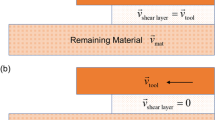Abstract
The goal of this work is to develop a method for detecting the creation of discontinuities during friction stir welding. This in situ weld monitoring method could significantly reduce the need for post-process inspection. A process force model and a discontinuity force model were created based on the state-of-the-art understanding of flow around an friction stir welding (FSW) tool. These models are used to predict the FSW forces and size of discontinuities formed in the weld. Friction stir welds with discontinuities and welds without discontinuities were created, and the differences in force dynamics were observed. In this paper, discontinuities were generated by reducing the tool rotation frequency and increasing the tool traverse speed in order to create “cold” welds. Experimental force data for welds with discontinuities and welds without discontinuities compared favorably with the predicted forces. The model currently overpredicts the discontinuity size.
Similar content being viewed by others
References
Balasubramaniana N, Mishra R, Krishnamurthy K (2011) Process forces during friction stir channeling in an aluminum alloy. J Mater Process Technol 211:305–311
Yan JH, Sutton M, Reynolds A (2007) Processing and banding in AA2524 and AA2024 friction stir welding. Sci Technol Weld Join 12:390–401
Seidel T, Reynolds A (2003) Two-dimensional friction stir welding process model based on fluid mechanics. Sci Technol Weld Join 3:175–183
Colligan K (1999) Material flow behaviour during friction stir welding of aluminum. Weld Res Suppl 78/7:229s–237s
Shercliff H, Colegrove P (2007) Process modeling. In: Mishra R, Mahoney M (eds) Friction stir welding and processing. ASM International, Materials Park, pp 187–217
Boldsaikhan E, McCoy M (2013) Analysis of tool feedback forces and material flow during friction stir welding. In: Mishra R, Mahoney MW, Sato Y, Hovanski Y, Verma R (eds) Friction stir welding and proceesing VII. Wiley, New Jersey, pp 311–320
Fonda R, Reynolds A, Feng C, Knipling K (2013) Material flow in friction stir welds. Mettall Mater Trans A 44A:337–334
Gratecap F, Girard M, Marya S, Racineux G (2012) Exploring material flow in Frdition stir welding: tool eccentricity and formation of banded stuctures. Int J Mater Form 5:99–107
Kumar K, Kailas SV (2008) The role of friction stir welding tool on material flow and weld formation. Mater Sci Eng A 485:367–374
Li W, Li J, Zhang Z, Gao D, Chao Y (2013) Metal flow during friction stir welding of 7075-T651 Aluminum alloy. Exp Mech 53:1573–1582
Boldsaikhan E, Corwin E, Logar A, Arbegast W (2011) The use of neural network and discrete Fourier transform for real-time. Appl Soft Comput 11:4839–4846
Fleming P, Lammlein D, Wilkes D, Fleming K, Bloodworth T, Cook G (2008) In-process gap detection in friction stir welding. Sens Rev 28/1:62–67
Burford D, Boldsaikhan E, Wiley A (2012) Early detection of volumetric defects using e-NDE during friction stir welding. In: 9th International Friction Stir Welding Symposium. The Von Braun Center, Huntsville, Alabama
Singh K, Hamilton C, Dymak S (2009) Developing predective tools for friction stir weld quality assessment. The International Congress on Sound and Vibration, Krakow
Fehrenbacher A, Duffie NA, Ferrier NJ, Pfefferkorn FE, Zinn MR (2014) Effects of tool–workpiece interface temperature on weld quality and quality improvements through temperature control in friction stir welding. Int J Adv Manuf Technol 71:165–179
Author information
Authors and Affiliations
Corresponding author
Rights and permissions
About this article
Cite this article
Shrivastava, A., Pfefferkorn, F.E., Duffie, N.A. et al. Physics-based process model approach for detecting discontinuity during friction stir welding. Int J Adv Manuf Technol 79, 605–614 (2015). https://doi.org/10.1007/s00170-015-6868-x
Received:
Accepted:
Published:
Issue Date:
DOI: https://doi.org/10.1007/s00170-015-6868-x




